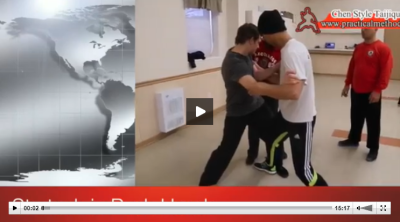Avoid tossing. One way is to do moves as if you are fighting and use power in it. Going over in the joints makes the noise of gedeng(咯噔),two metal with rubber on it.
Avoid injuries in the joints. Whenever issue power, it is a stretch, not a squeeze/compress. The only compression is the hand to the opponent and the foot to the floor, others only stretch. Like the spring or a shaft. Damage will happen because it is leaking sideways or there is no consistency. Example: the Japanese sword made with seven pieces welted together. Each part has its specialized cutting skill ie. how and what kind of material to cut. The joints work the same way. Each bone has different functions. The joints need open up to issue power, which may cause compression in other joints. Taiji has specific crooked body positions. The eight techniques: four cardinals and four diagonals. The four diagonals are not on the same plane but three dimensional crossed on different angles in space, which is what we train. It is crooked. Like when you cut veggies, and there is a type that you have to adjust the knife into different angles all the time to cut. The diagonals are the corners/45 degrees in application, power goes to the joints and it is crooked. You train the twist, in use it is a flow, but causing the opponents’ joints to be crooked.
To dig. Second move in BWAPM. Spoon. The hand is the handle, not move, the shoulder is the spoon to dig. The hand is like a carabiner locked to the wall. It is moving but not moving. On the turn, the middle is locked, you adjust the left and right. More or less, because of the kua restriction, we lean to one side. On the stepping up, it is one move led by the kua, no preparation. Block touching coat. Third move. Open half way, that certain position is important to make sure you can issue the power, then use the rotation of the torso to open the arms. When we use power, never go too straight, go 80-85% so you won’t hurt yourself by pulling the muscles. Forth move, the kua has to meet the elbow, goes towards the direction of the elbow coming in. The coordination of elbow shoulder kua, sth is missing and that is the lack of training. When fanjin, stance can be smaller so it is easier to coordinate.
Every move comes from the foot. The feet has to have sturdy firm good grip.
Compass. Three types of not moving: 1.one needle fixed to the floor, absolute not moving; 2.着-zhuo, the other needle fixed to the rag, the relationship/structure between the needle and the rag does not change; 3. stay on the track. The opponent moves with the rag. In push hands, the opponent moves around you. It is the mirror/effect of your actions, not the actions themselves.
Online Lesson with Master Chen Zhonghua 6th Aug 2021-Yuxin Liu
Previous post: Online Lesson with Master Chen Zhonghua 5th Aug 2021-Yuxin Liu
Next post: “Berlin 17 (4)” Online Video Purchase


